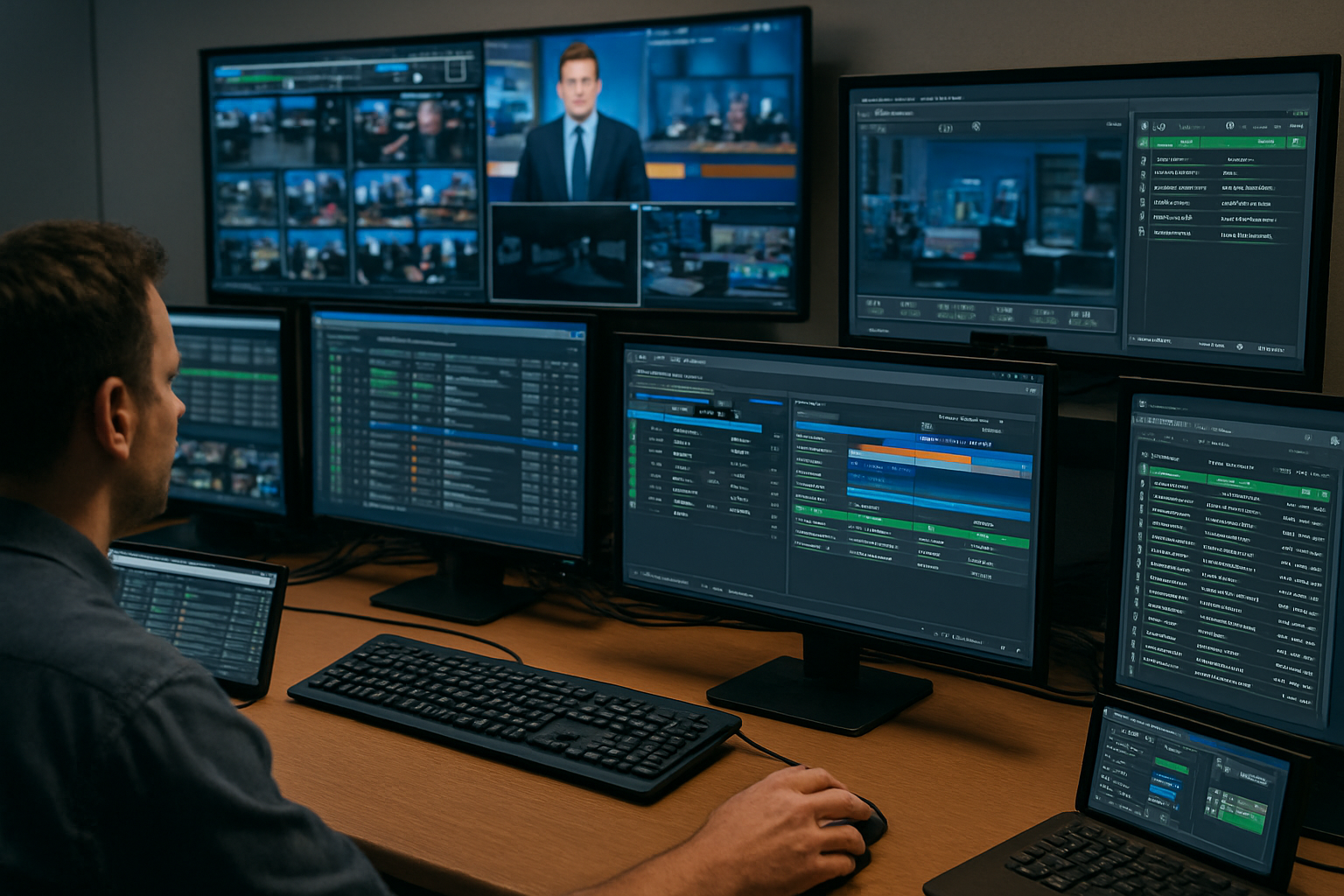How a Studio Works: A Look at the Software Behind the Scenes

When you think of a TV studio or video production environment, it’s easy to picture cameras, lights, and people wearing headsets. But just as important—and sometimes more critical—is the software that powers the entire workflow. From scheduling and playout to graphics and media asset management, software is what holds the operation together.
Let’s walk through how a typical studio functions, focusing on the key tools used at each stage.
1. Planning and Scheduling
Before anything gets recorded or goes live, there’s a plan—and that plan is built in a Broadcast Management System (BMS).
Software tools:
- BMS (Broadcast Management System) – used to schedule programming, assign rights windows, book commercial slots, and coordinate with sales.
- Traffic systems – often integrated with BMS to manage ad inventory and sponsorships.
- Rundown or script software (like Octopus, ENPS, or MOS-based tools) – where the editorial team writes and sequences scripts, stories, and segments.
These systems are usually connected to automation and playout software later down the line, so everyone’s working from the same data.
2. Media Management and Preparation
Once shows are scheduled and scripts are written, the right media needs to be located, reviewed, and prepared.
Software tools:
- MAM (Media Asset Management) – software like VSNExplorer, Dalet, or custom-built solutions help organize video files, attach metadata, and make them searchable.
- Transcoding and QC tools – such as Telestream Vantage or FFmpeg-based systems to convert files into the right formats and check for errors.
- Storage management – large media storage systems use software to tier files between fast-access, archive, and cloud storage.
Some broadcasters even build their own asset workflows using SDKs—like Medialooks customers have done—to tailor tools to their own needs.
3. Production: Live or Recorded
When the actual show is being made—whether it’s live news or a pre-recorded series—a whole suite of production software is in use.
Software tools:
- Vision mixing and playout automation – tools like Vizrt, Ross OverDrive, or Evertz DreamCatcher help switch between camera feeds, trigger graphics, and control playback.
- Graphics engines – like CasparCG, Chyron, or Viz Engine, for creating lower-thirds, overlays, tickers, and real-time visual elements.
- Audio mixing and routing – controlled via software linked to digital audio consoles (e.g., Lawo, Axia, Wheatstone).
- Teleprompter software – used to display scripts to presenters in sync with the rundown.
- Studio automation systems – tie all of the above together, allowing directors to trigger sequences of actions with a single button (e.g., load graphics, switch camera, cue clip).
Modern studios often use remote production platforms too, which rely on cloud-based software and WebRTC tech to allow control from anywhere.
4. Post-Production and Archiving
After a recording or broadcast, everything is edited, packaged, and either published or stored for later use.
Software tools:
- Non-linear editing (NLE) platforms – such as Adobe Premiere Pro, DaVinci Resolve, Avid Media Composer, or Final Cut Pro.
- Color grading, effects, and audio post – done using specialized software like Resolve, After Effects, or Pro Tools.
- Publishing and transcoding software – for delivery to broadcast servers, streaming platforms, or social media (often automated with tools like Vantage, Woody Technologies, or even custom API scripts).
- Archive systems – long-term storage is often handled by MAM-integrated archive software, linked to LTO tape or cloud services.
5. Monitoring and Analytics
Finally, there’s the software that makes sure everything is actually working—before the audience notices if it’s not.
Software tools:
- Playout monitoring – real-time signal monitoring and confidence playback using solutions like TAG Video Systems, Tektronix, or even browser-based dashboards.
- Logging and compliance – required in many countries to keep records of what was aired, when, and for how long.
- Audience and performance analytics – viewership data from Nielsen, Barb, or platform-native tools helps plan future content and scheduling.
Behind every smooth studio operation is a network of software systems working together—some tightly integrated, others held together by well-worn workflows and maybe a few clever workarounds. From the script to the screen (and everything in between), software is what turns creative plans into actual broadcasts.
Whether it’s live news, sports, or entertainment, the more complex the production, the more essential the software becomes.
